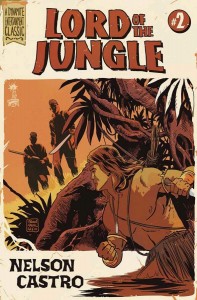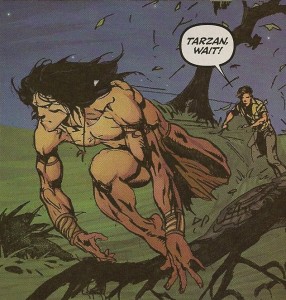 It’s kinda hard to review Lord of The Jungle because, like much of Generation X, I don’t have much of a relationship with the character of Tarzan. The Johnny Weismuller flicks were well before my time. Greystoke: The Legend of Tarzan, Lord of The Apes opened just before (and was doomed to lose my eyeballs to) Ghostbusters and Gremlins. And 1981’s Tarzan, The Ape Man was something you taped off of HBO late at night to fast forward to the Bo Derek nude scenes for to see if your dinkle would do that spiffy trick again.
It’s kinda hard to review Lord of The Jungle because, like much of Generation X, I don’t have much of a relationship with the character of Tarzan. The Johnny Weismuller flicks were well before my time. Greystoke: The Legend of Tarzan, Lord of The Apes opened just before (and was doomed to lose my eyeballs to) Ghostbusters and Gremlins. And 1981’s Tarzan, The Ape Man was something you taped off of HBO late at night to fast forward to the Bo Derek nude scenes for to see if your dinkle would do that spiffy trick again.
So, having more of a history with Captain Caveman than with Tarzan, I can only rate this book on its individual merits, of which it has several. Unfortunately, pacing doesn’t seem to be one of them. But we’ll get back to that in a minute.
Last month’s first issue was pure setup, putting Tarzan’s parents into the jungle to set up Tarzan’s apparent orphaning and adoption by apes. We start issue 2 twenty-one years later, with mutineers landing on the coast of the Congo jungle with their prisoners: an English Indiana Jones-looking guy named Cecil Clayton, one Professor Porter, and his daughter Jane… and even I know who Jane is, despite being half-convinced that if Tarzan was raised by apes, by 21 years old, he’d be fucking one, based purely on my complete lack of background in biology and observations of friends’ dogs who seem utterly willing to marry my leg.
What works in this issue are the characterizations… up to a point. We see Clayton in classic 1910, “The sun never sets on the British empire, pip-pip!” honor and manners mode, even when dealing with an armed bandit, in a way that feels familiar, at least as pulp fiction goes… even if such a mannerism never actually existed. That selfsame armed bandit’s willingness to backshoot Clayton also feels natural – his cowardice in a fair fight is established early, and after only a few pages, even I was tempted to put two in Clayton… although with the first name Cecil, he less triggers my Homicidal Violence instinct than my Atomic Wedgie one.
Jane, however, is a cipher here; a blonde set of tits to put in danger by the end of this issue to be rescued by Tarzan in the next. The same kind of broad-stroke characterization falls on Jane’s father – pick the absent-minded professor of your choice, be it Jerry Lewis or Doc Brown, and you have Professor Porter down pat already – and all the other mutineers, who spit out “fink” for “think,” “somefin” instead of “something,” proudly admit illiteracy, and frankly do everything but stick knives in their teeth and snarling, “Yarrrr!” On one hand, this kind of characterization isn’t exactly foreign to pulp fiction; after all, the genre that brought us Dr. Fu Manchu and Shiwan Khan isn’t exactly known for erring on the side away from hideous and broad stereotypes. But on the other, it’s 2012, and it really feels like almost everyone here exists only to advance the plot.
And advance, the plot does: in 22 pages, we get bandits burying treasure, a murder, a spear attack, an alligator attack, and a panther attack. We meet three main characters, a fistful of supporting characters, and a bunch of douchebag pirates who seem to provide tension but it turns out are only Jane’s ride to the jungle. A no one can accuse writer Arvid Nelson of not keeping things moving, but it all feels rushed to me. The plot’s source of tension shifts about six times during the book, which means it delivers on the action, but it feels very A.D.D. to me.
Roberto Castro’s art on the book generally works for me. It’s an interesting mix of what feels like the bastard child of Sal Buscema’s work on Conan (look at that splash of Tarzan killing the alligator and tell me he isn’t a battle axe away from shouting “Crom!”) and 90s-style finely-inked crosshatching and shading. I was initially going to compare the inking to Rob Liefeld, except those are fighting words in a large percentage of the comics world, and besides: Castro can draw feet. He sometimes, however, has problems with legs.
 What should have been a dynamic panel of Tarzan leaping to rescue Jane for the first time instead stopped me dead to say, “Where the fuck is Tarzan’s Goddamned left leg!?” I’m guessing that the leg went down in the coloring process – and the coloring on this book has a lush, watercolored look to it that is beautiful – but it’s the kind of error that can yank you straight out of a book. It’s the only such error I could find in the book… but it’s one more than should be there. Particularly considering that 10 percent of copies of this book have a cover by Francesco Francavilla – the cover I grabbed and displayed above – who most recently did excellent work on Black Panther and who draws pulp art like nobody’s business, you don’t want to be giving anyone an excuse to hire Francavilla on full time.
What should have been a dynamic panel of Tarzan leaping to rescue Jane for the first time instead stopped me dead to say, “Where the fuck is Tarzan’s Goddamned left leg!?” I’m guessing that the leg went down in the coloring process – and the coloring on this book has a lush, watercolored look to it that is beautiful – but it’s the kind of error that can yank you straight out of a book. It’s the only such error I could find in the book… but it’s one more than should be there. Particularly considering that 10 percent of copies of this book have a cover by Francesco Francavilla – the cover I grabbed and displayed above – who most recently did excellent work on Black Panther and who draws pulp art like nobody’s business, you don’t want to be giving anyone an excuse to hire Francavilla on full time.
This is not a bad comic book by any stretch of the imagination, but it feels rushed, and packed full of broadly-stroked characters that sometimes work, but other times feel like caricatures. What’s here might be a dead-on reproduction of the original Burroughs Tarzan stories, which would probably excite fans of those books, but for those of us who are only vaguely familiar with the source material from other adaptations? If things don’t settle down to a more steady and relatable pace soon, I might start flipping through the pages looking for images that make my dinkle do tricks.
 Podcast RSS Feed
Podcast RSS Feed iTunes
iTunes Google Play
Google Play Stitcher
Stitcher TuneIn Radio
TuneIn Radio Android
Android Miro Media Player
Miro Media Player Comics Podcast Network
Comics Podcast Network